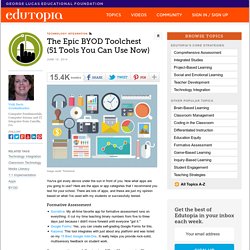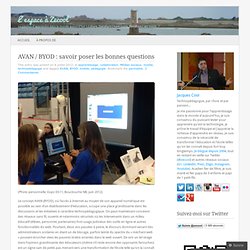

Francois Guite sur Twitter : "'Tweeting could help children focus in class,' study says. The Epic BYOD Toolchest (51 Tools You Can Use Now) You've got every device under the sun in front of you.

Now what apps are you going to use? Here are the apps or app categories that I recommend you test for your school. There are lots of apps, and these are just my opinion based on what I've used with my students or successfully tested. Formative Assessment Socrative: My all-time favorite app for formative assessment runs on everything. Screencasting and Capturing What Happens in Class If you're going to share and interact with your students in the electronic and physical spaces (as you should), you must learn how to screencast.
Screencastomatic: This is my go-to app. Content-Sharing Platforms Your school is bricks and clicks. Sophia: Nudged along by my friend Todd Nesloney, I use Sophia for my computer applications instruction and am very pleased with the results.Haiku Learning: This is the full content management system that I'm trying to get our school to adopt. There are many other apps like Moodle, Canvas, and Coursesites. Expression. Some Schools Urge Students to Bring Their Own Technology. Some Schools Urge Students to Bring Their Own Technology. Why It's Time To Start BYOD In Your School. I remember fondly, my time as a young and plucky probationary teacher. Exploring the realities of classroom practice and experimenting with new pedagogy. I recall quite clearly the time when my first classroom was equipped with a single desktop computer.
Today, it is equipped with 30 desktop computers, a projector, an interactive whiteboard, a visualiser, an A3 colour printer, a laser printer and even a 3D Printer. The Gradual Shift Yet, one could argue that somewhere on this journey, my pedagogy has lost focus and that there remains disconnect between my ambition for interactive learning through technology and the realities of my practice. Let’s explore this concept… From the teacher perspective, the learning environment could be seen as technology-rich, including the integration of teaching aides; an arsenal of technology placed at the teacher’s disposal.
The flipped perspective, from the student’s point of view can be very different. Why BYOD? Next Generation Of Learning. AVAN / BYOD : savoir poser les bonnes questions. (Photo personnelle, Expo DS11, Bouctouche NB, juin 2012) Le concept AVAN (BYOD), où l’accès à Internet au moyen de son appareil numérique est possible au sein d’un établissement d’éducation, occupe une place grandissante dans les discussions et les initiatives à caractère technopédagogique.

On peut maintenant concevoir des réseaux sans fil, ouverts et néanmoins sécurisés où les intervenants dans un milieu éducatif (élèves, personnel, partenaires) font usage judicieux des outils en ligne et autres fonctionnalités du web. Pourtant, deux ans passées à peine, le discours dominant venant des administrateurs scolaires en étant un de blocage, parfois teinté du spectre du « méchant web » pouvant écorcher vives les pauvres brebis errantes dans le web ouvert. De voir un tel virage dans l’opinion grandissante des éducateurs (même s’il reste encore des opposants farouches) est un signe sain de petits pas menant vers une transformation de l’école telle qu’on la connaît depuis fort trop longtemps.
Bring Your Own Device (BYOD) in Schools - Considerations. Many schools are looking to implement Bring Your Own Devices (BYOD) to give students and staff access to personal devices such as laptops, tablets and smartphones in classrooms. As technology becomes more and more affordable, students will undoubtedly have access to internet enabled devices at home for learning. However, due to schools budget constraints, the same cannot be said when they are in school. This causes a disparity in how they access information. So how do we address this inconsistency? Technology never stands still and it is becoming increasingly hard for schools to keep up, especially on a limited budget. So, what would a school need to consider when implementing BYOD? Planning Stage The planning stage for a scheme such as BYOD is especially key in ensuring the agreement and support of all parties involved.
Communication: Start conversations with all stake holders; governors, parents, teachers, students and identify the strengths and weaknesses of BYOD. Final Thoughts. BYOD in the 21st Century (RÉCIT Anglo)